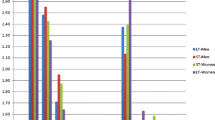Abstract
Sex-role is a product of interpersonal and intrapersonal cognitive functioning. As a result, parents play an important role in the development of their children's sex-role orientation. The aim of this research was to describe the relationship between the sex-role of adults and those of their parents as measured on the Bem Sex-Role Inventory (Bem, 1974). Inventories were completed by 24 men, 41 women, and their parents. Results show the strongest relationship for gender-consonant sex-roles for mother-daughter and father-son dyads. Findings are discussed in terms of sex-role and modeling theories.
Similar content being viewed by others
References
Bem, S. L. (1974). The measurement of psychological androgyny.Journal of Consulting and Clinical Psychology, 42, 155–162.
Block, J. H. (1973). Conceptions of sex role: Some cross-cultural and longitudinal perspectives.American Psychologist, 28, 512–526.
Chodrow, N. (1974). Family structure and feminine personality. In M. Z. Rosaldo & L. Lamphere (Eds.),Woman, culture and society (pp. 43–46). Stanford: Stanford University Press.
Fleishman, E. G. (1983). Sex-role acquisition, parental behavior, and sexual orientation: Some tentative hypotheses.Sex Roles, 9, 1051–1059.
Juni, S. (1992). Familial dyadic patterns in defenses and object relations.Contemporary Family Therapy, 14, 259–268.
Juni, S., Rahamim, E. L., & Brannon, R. (1985). Sex role development as a function of parent models and oedipal fixation.Journal of Genetic Psychology, 146, 89–99.
Kelly, J. A., & Worell, J. (1976). Parent behaviors related to masculine, feminine, and androgynous sex role orientations.Journal of Consulting and Clinical Psychology, 44, 843–851.
Maccoby, E. E., & Jacklin, C. N. (1974).The psychology of sex differences. Stanford, CA: Stanford University Press.
Money, J., & Eckhardt, A. A. (1972).Man and woman, boy and girl. Baltimore: Johns Hopkins University Press.
Robinson, B. E., & Green, M. G. (1981). Beyond androgyny: The emergence of sex-role transcendence as a theoretical construct.Developmental Review, 1, 247–265.
Spence, J. T., Helmreich, R., & Stapp, J. (1975). Ratings of self and peers on sex role attributes and their relation to self-esteem and conceptions of masculinity-femininity.Journal of Personality and Social Psychology, 32, 29–39.
Author information
Authors and Affiliations
Rights and permissions
About this article
Cite this article
Juni, S., Grimm, D.W. Sex-role similarities between adults and their parents. Contemp Fam Ther 15, 247–251 (1993). https://doi.org/10.1007/BF00894398
Issue Date:
DOI: https://doi.org/10.1007/BF00894398




